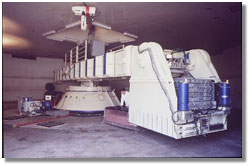 |
|
|
 |
||
|
||||||||||||||||||
|
Earthquake Research Speeded by Networking
|
||||||||||||||||||
|
Photo Credit: UC-Davis |
|
Researchers and engineers from New York to California are forming a collaborative network via the Internet to speed the design of structures that minimize earthquake damage and loss of life. The National Science Foundation (NSF) has announced 11 awards totaling $45 million to fund shake tables, centrifuges and other experimental equipment that can be shared across the nation to study earthquake effects.
"The past decade has seen immense devastation from major earthquakes around the world," said Priscilla Nelson, NSF division director for civil and mechanical systems. "We can't control the destructive forces of nature. But this equipment can help us design and construct buildings, bridges and other structures that can better withstand those forces."
The awards are part of the George E. Brown, Jr. Network for Earthquake Engineering Simulation (NEES). NEES is a collaboration designed to improve the seismic design and performance of the U.S. civil and mechanical infrastructure. NSF plans to spend up to a total of $81.9 million by 2004 under NEES to enhance earthquake engineering research equipment in the United States and to build a high performance Internet network to connect the equipment facilities.
The current equipment awards, totaling $45 million over four years, will fund construction, expansion and modernization of equipment at 10 universities that will include capabilities for remote observation and operation. The equipment includes new and upgraded shake tables, centrifuges, a tsunami wave basin, largescale laboratory experimentation systems, and field experimentation and monitoring installations. NSF hopes to grant a second set of equipment awards in the future. All equipment is expected to be operational by late 2004.
A six-month scoping study already underway is defining user requirements, hardware and software technologies, and support infrastructure needed for the network. The University of Illinois at Urbana-Champaign leads the scoping team.
Eventually, a community-led consortium will be selected to manage and operate NEES for at least 10 years.
The NEES program was renamed in November 2000 by an Act of Congress to honor the late George E. Brown, Jr., former chairman of the House Science Committee and a champion of engineering and science in Congress for over 30 years.
![]()
Attachment: NEES Equipment Awards
For more information, see http://www.eng.nsf.gov/nees
![]()
Attachment
NEES Equipment Awards
Oregon State University - $4.78 million
Principal Investigator: Solomon Yim
Upgrading Oregon State's Multidirectional Wave Basin
for Remote Tsunami Research
Rensselaer Polytechnic Institute, New York $2.38
million
Principal Investigator: Ricardo Dobry
Upgrading, Development and Integration of Next Generation
Earthquake Engineering Experimental Capability at
Rensselaer's 100 g-ton Geotechnical Centrifuge
State University of New York at Buffalo - $6.16
million
Principal Investigator: Michel Bruneau
Versatile High Performance Shake Tables Facility Towards
RealTime Hybrid Seismic Testing
State University of New York at Buffalo - $4.38
million
Principal Investigator: Michel Bruneau
Large-Scale High Performance Testing Facility Towards
Real-Time Hybrid Seismic Testing
University of California at Berkeley - $4.27
million
Principal Investigator: Jack Moehle
Reconfigurable Reaction Wall- Based Earthquake Simulator
Facility
University of California at Davis - $4.61 million
Principal Investigator: Bruce Kutter
A NEES Geotechnical Centrifuge Facility
Unversity of California at Los Angeles - $2.65
million
Principal Investigator: John Wallace
Field Testing and Monitoring of Structural Performance
University of Colorado at Boulder - $1.98 million
Principal Investigator: Benson Shing
Fast Hybrid Test Platform for the Seismic Performance
Evaluation of Structural Systems
University of Minnesota - $6.47 million
Principal Investigator: Catherine French
A System for Multi-Axial Subassemblage Testing
University of Nevada at Reno - $4.40 million
Principal Investigator: Ian Buckle
Development of a Biaxial Multiple Shake Table Research
Facility
University of Texas at Austin - $2.94 million
Principal Investigator: Kenneth Stokoe II
Large-Scale Mobile Shakers and Associated Instrumentation
for Dynamic Field Studies of Geotechnical and Structural
Systems
|
|
